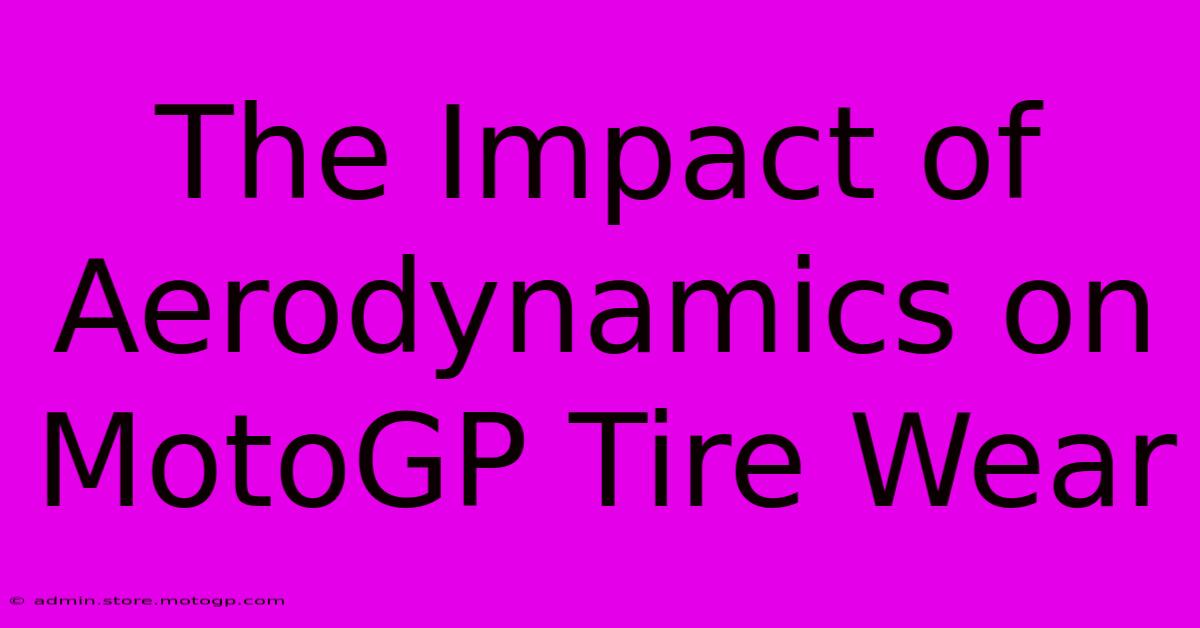The Impact Of Aerodynamics On MotoGP Tire Wear

Table of Contents
The Impact of Aerodynamics on MotoGP Tire Wear
MotoGP racing pushes the boundaries of motorcycle technology, and tire management is a crucial element determining race outcomes. While rider skill and tire compound play significant roles, the often-overlooked factor of aerodynamics significantly impacts tire wear. This article delves into the complex interplay between aerodynamic forces and tire degradation in MotoGP.
Understanding Aerodynamic Downforce and Drag
Before exploring the impact on tire wear, let's clarify the key aerodynamic forces at play:
-
Downforce: This is the force pushing the motorcycle downwards, increasing grip and stability. It's generated by aerodynamic devices like winglets, fairings, and the overall bike design. More downforce means more grip, but it also means increased tire load and subsequent wear.
-
Drag: This is the resistive force acting against the motorcycle's motion. High drag reduces top speed and requires more power, indirectly contributing to tire wear through increased engine strain and heat generation.
How Aerodynamics Affects Tire Wear
The relationship between aerodynamics and tire wear is multifaceted:
1. Increased Tire Load and Contact Pressure:
High downforce significantly increases the load on the tires, especially the front. This increased load translates to higher contact pressure, leading to accelerated wear, particularly in the center of the tire. Aggressive aerodynamic setups, while beneficial for cornering speed, can drastically shorten tire lifespan.
2. Heat Generation and Degradation:
Downforce isn't just about increased load; it also generates heat. The increased friction from the higher contact pressure, coupled with the heat generated by braking and acceleration, accelerates tire degradation. This heat buildup can lead to blistering, graining, and overall reduced tire performance.
3. Uneven Tire Wear Patterns:
The aerodynamic forces aren't evenly distributed across the tires. The front tire typically bears the brunt of the increased load from downforce, leading to uneven wear patterns. This can manifest as faster wear in the center compared to the edges, potentially compromising stability and grip. Furthermore, specific aerodynamic configurations can cause localized pressure points, leading to premature wear in certain areas.
4. Impact of Yaw and Slip Angle:
Aerodynamic forces affect a motorcycle's yaw (rotation around a vertical axis) and slip angle (angle between the tire's direction and the motorcycle's direction). These factors further influence tire wear. Aggressive aero packages can amplify these effects, potentially exacerbating tire wear, especially under braking and cornering.
Minimizing Aerodynamically Induced Tire Wear
MotoGP teams constantly strive to optimize aerodynamic performance while minimizing tire wear. Strategies include:
-
Careful Aerodynamic Design: Teams employ sophisticated Computational Fluid Dynamics (CFD) simulations to optimize aerodynamic components, aiming for a balance between downforce and drag.
-
Tire Compound Selection: Selecting the right tire compound for the track conditions and aerodynamic setup is crucial. Softer compounds offer better grip but wear faster, while harder compounds are more durable but may lack grip.
-
Rider Technique: Skilled riders can mitigate the effects of high downforce through refined riding techniques, minimizing unnecessary tire slip and heat generation.
-
Strategic Tire Management: Tire changes and consistent monitoring are essential to manage wear throughout the race, adjusting riding style accordingly.
Conclusion
Aerodynamics is a critical, often-underestimated factor influencing tire wear in MotoGP. Understanding the complex interplay between downforce, drag, and tire performance is vital for optimizing race strategy and maximizing tire lifespan. The constant push for higher speeds and improved cornering capabilities underscores the ongoing challenge of balancing aerodynamic advantages with the need for tire preservation. Future advancements in aerodynamic design and tire technology will undoubtedly continue to shape the dynamics of this critical aspect of MotoGP racing.

Thank you for visiting our website wich cover about The Impact Of Aerodynamics On MotoGP Tire Wear. We hope the information provided has been useful to you. Feel free to contact us if you have any questions or need further assistance. See you next time and dont miss to bookmark.
Featured Posts
-
Moto 2 Bike Specs Master The Art Of Moto 2 Racing With These Specs
Feb 19, 2025
-
Experience The Thrill F1 Austin Concert Awaits
Feb 19, 2025
-
The Best Motorcyclist A Tale Of Triumph And Tragedy
Feb 19, 2025
-
Malaysian Motorcycle Grand Prix Experience The Energy
Feb 19, 2025
-
Moto2 Motorcycles Inspiring The Next Generation
Feb 19, 2025
